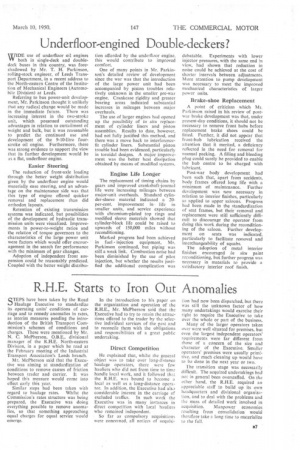R.H.E. Starts to Iron Out Anomalies
Page 41

If you've noticed an error in this article please click here to report it so we can fix it.
STEPS have been taken by the Road Haulage Executive to standardize its operating units' conditions of carriage and to remedy anomalies in rates, as interim measures pending the introduction of the British Transport Commission's schemes of conditions and charges. These were mentioned by Mr. N. C. McPherson, 0.B.E., divisional manager of the R.H.E. North-eastern Division, in a paper which he read at the February meeting of the Industrial Transport Association's Leeds branch.
Mr. McPherson said that the Executive was aiming at standardization of conditions to remove causes of friction between trader and carrier. It was hoped this measure would come into effect early this year.
Similar steps had been taken with regard to haulage rates. Whilst the Commission's rates structure was being prepared, the Executive was doing everything possible to remove anomalies, so that something approaching equal charges for equal service would emerge.
In the introduction to his paper on the organization and operation of the R.H.E., Mr. McPherson said that the Executive had to try to retain the attractions offered to the trader by the selective individual services of the past and to reconcile them with the obligations and responsibilities of a great public undertaking.
Direct Competition He explained that, whilst the general object was to take over long-distance haulage operators, there were few hauliers who did not from time to time handle local work, and it followed that the R.H.E. was bound to become a local as well as a long-distance operator. In addition, the Executive had also considerable interest in the carriage of excluded traffics. In such work the Executive was in many instances in direct competition with local hauliers who remained independent.
So far as compulsory acquisitions were concerned, all notices of acquisi
tion had now been dispatched, but there was still the unknown factor of how many undertakings would exercise their right to require the Executive to take over the whole or part of the business.
Many of the larger operators taken over were well situated for premises, but even the largest independent operators' requirements were far different from those of a concern of the size and character of the Executive. Smaller operators' premises were usually primitive, and much cleaning up would have to be done in the next year or two.
The transition stage was necessarily difficult. The acquired undertakings had not in general been overstaffed. On the other hand, the R.H.E. required an appreciable staff to build up its own headquarters and divisional organization, and to deal with the problems and the mass of detailed work involved in acquisition. Man power economies resulting from consolidation would therefore take a long time to materialize to the full.




















































































